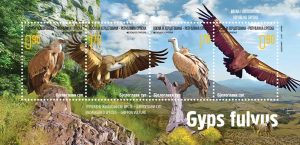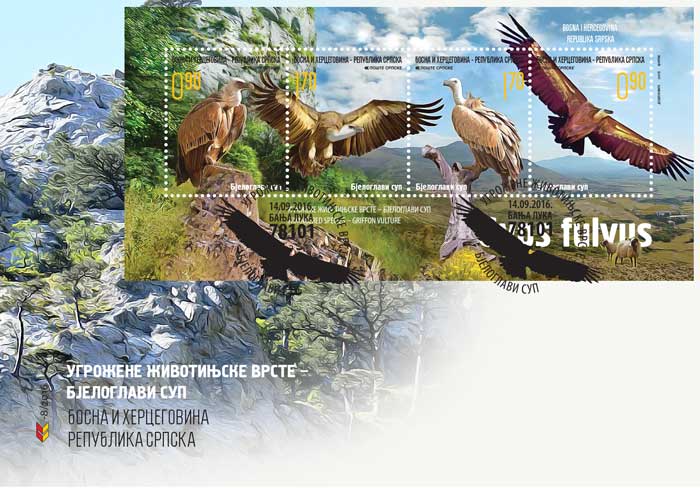Endangered Species - Griffon Vulture
Title::Endangered Species - Griffon Vulture
Date of Issue:14.09.2016.
Author:Bozidar Dosenovic
Type edition:commemorative
Printing techniques:multicolour offset
Sheet:block
Paper:muflep 100g
Printing House:Forum, Novi Sad
 Motive:Griffon Vulture
Motive:Griffon Vulture
Catalogue no.:695, 696, 697, 698
Perforation:13 3/4
Face value:5,20 BAM
Quantity:20 000


Аmong all birds, the most endangered groups are the birds of prey. All four species of eagles, vultures, we lost in the Republic of Srpska.
Popovo polje and Mount Bjelasnica is one of the last habitats of griffon vulture nesting in eastern Herzegovina. In this area the last flock was seen in the late 20th century. According to available data, the last colony of griffon vulture in the Popovo polje disappeared with the beginning of the war in 1991. Part of that flock settled on Uvac, which increased the number of population in Serbia.
Griffon vulture is a large and noticeable bird of prey that weighs up to 8.5 kg, while the wingspan can reach 2.8 m and are adapted to sailing on air currents. Griffon Vulture nests on the rocks, forming a smaller or larger group of nests (colonies). Female bears only one egg. Life expectancy in the nature of them is about 20 years. Unlike other species of vulture, feeds on dead animals, the most common soft tissue of dead ruminants and thus carry out the sanitary role in the nature, preventing the spread of various diseases. It is located in CITES Appendix II list and represents the kind of disappearing. EU Birds Directive (Council of Europe 1979 b) puts it in Appendix I of endangered bird species in Europe.
Its specific flight draws the attention of the viewer and be inspired generations. The legendary bird has had a strong influence in the development of human society and is part of the culture of ancient peoples and empires throughout the history of civilization. Griffon vulture is a mythical bird, part of the collective memory of the medieval Serbia and found it on the coats of arms of the dynasty Mrnjavcevic, Nemanjic, Lazarevic and Crnojevic. This special kind of birds draws the attention to the need to preserve biodiversity and is often mentioned as an attribute of local communities for nature conservation and tourism development.
Author: MA Bozidar Dosenovic
Publisher: Poste Srpske a.d. Banjaluka
Cooperation: Dejan Radosevic, BA in Ecology, Republic Institute for Protection of Cultural and Natural Heritage
 1371
1371  kontakt@postesrpske.com
kontakt@postesrpske.com


